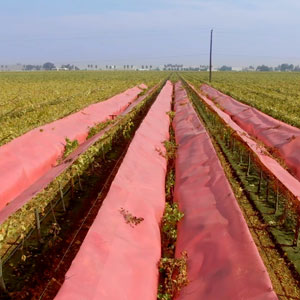Increasing food production without using additional water and land resources could be possible through further developments in irrigation and water engineering, plant breeding and gene editing, and innovative management of things like heat and sunlight.
Those are some of the strategies outlined during a panel discussion called “New innovations, incentives to grow fruits, vegetables and other crops with less water” at the Agri-Pulse Food and Ag Issues Summit West in Sacramento on Monday.
Jonathan Destler, CEO of Opti-Harvest, said his company applies to outdoor crops the science of how light is used for indoor or greenhouse growing. The company works with grapes, nuts, citrus and stone fruit and is moving into blueberries and avocados with technologies that “get light into the more shaded areas of the canopy or the trellis system” — or shield fruit during a time of excessive heat, for example.
Across 60 trials in six years, he said yield has increased and labor costs have gone down.
The goal, he said, is to create stronger, healthier plants by considering sunlight as one among the many inputs at a farmer’s disposal to select and maximize. He said initially the company was able to measure benefits above ground, but now they’re able to document enhanced root systems and corresponding improvements in water use efficiency.
 Opti-Harvest's Opti-Panel“We're excited to, we believe, offer some part of a solution that can help as an integrated approach,” he said, “along with other genetics and chemicals and soil enhancements.”
Opti-Harvest's Opti-Panel“We're excited to, we believe, offer some part of a solution that can help as an integrated approach,” he said, “along with other genetics and chemicals and soil enhancements.”
Bayer also hopes to improve plant health and success even when conditions change. Stephanie Pedroni, new technologies coordinator for global vegetable research and development at Bayer, said that while the company is best known for major row crops, it also has a strong program in specialty crops, and the work is complementary.
“Trials that we conduct in cotton, we're able to glean learnings and apply those to processing tomatoes, and vice versa,” she said.
For her, the bright spot for crop innovation right now is gene editing, a process she said will shave years off the process of developing a plant that takes advantage of certain beneficial genetics. The price of sequencing genetic material has plummeted, making it a readily accessible tool, Pedroni said. In the past, once desirable genetics were identified, that bit had to be isolated and then tested to see whether it could be added or removed without causing other unwanted results. That took months or years to grow out successive generations of plants.
With gene editing, though, Pedroni said, “we can affect one precise change, where nothing else in the genome of that plant is affected.” That means faster and more precise changes that get seeds to farmers sooner.
She said drought in California and the West, along with other challenges from climate change, underscores the need to “use all the tools at our disposal if we're going to be successful.” In addition to improving genetics, she pointed to soil health for creating better roots and various strategies for pest management.
Water remains one of the tightest resources for many fruit, nut and vegetable growers, especially in California and the southwest. Common Good Water is developing a paradigm that pays farmers for water they don’t use. It’s part of the incentive structure that chief development officer Val Fishman said is baked into the company’s business model. Using existing technology from Netafim, she says the company has helped alfalfa farmers cut their applied water by about half compared to the state average. With California a leading dairy state, alfalfa is a critical crop.
Subsurface drip technology is paired with best agronomic practices, she said, and other benefits follow, such as carbon sequestration, improved soil health and increased profit. Meters measure, and a third party verifies, how much water the farmers have used.
“Our model is to actually pay them based on the amount of water they save,” Fishman said.
Micro-irrigation and other control measures prevent precious drops of water from escaping the plants they are intended for. And while Common Good Water is accounting for actual water used, Daniele Zaccaria, an agriculture water management specialist at the University of California, Davis, said not all innovations do.
Don’t miss a beat! It’s easy to sign up for a FREE month of Agri-Pulse news! For the latest on what’s happening in Washington, D.C. and around the country in agriculture, just click here.
Already, he said, water use is approaching 96% efficiency in California, meaning very little is wasted. But he cautions that it also does not mean water use is sustainable.
 L to R: Spencer Chase, Agri-Pulse; Jonathan Destler, Opti-Harvest; Daniele Zaccaria, UC Davis; Val Fischman, Common Good; Stephanie Pedroni, Bayer
L to R: Spencer Chase, Agri-Pulse; Jonathan Destler, Opti-Harvest; Daniele Zaccaria, UC Davis; Val Fischman, Common Good; Stephanie Pedroni, Bayer
“Still we (are) overdrafting aquifers and we (are) over-allocating rivers,” he said, so efficiency and sustainability are really separate concerns. He said engineering can improve how and when water is moved, and while that often translates into higher yields, it also means there is often a net increase in the overall water use because more acres are irrigated.
“Unless we create the framework for having better water accounting, and somehow put in place a way to maximize the amount of water allocation and the net benefit of that water allocation per acre, we are not going to reach the target for the community of reducing (water use),” he said.
If the goal of sustainable water use is to protect groundwater, he explained, then water management practices that increase crop yield per acre and, therefore, encourage irrigation of more acres, are not the tools to achieve it.
Common Good Water, Fishman said, hopes to achieve actual conservation in addition to giving farmers a new revenue source. She said that’s why they commit to working with a given farm for seven years.
“The reason we stay with the farm is to make sure that those water savings are achieved, that they're getting the yield that they want, that they're applying the right amount of water, that they've got a very robust pest management system in place and all of those things,” she said. The company hopes to expand into other crops.
The demands of the Sustainable Groundwater Management Act and the ongoing drought will, no doubt, leave plenty of farms continuing to look for water solutions.
For more news, go to www.Agri-Pulse.com.

